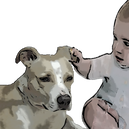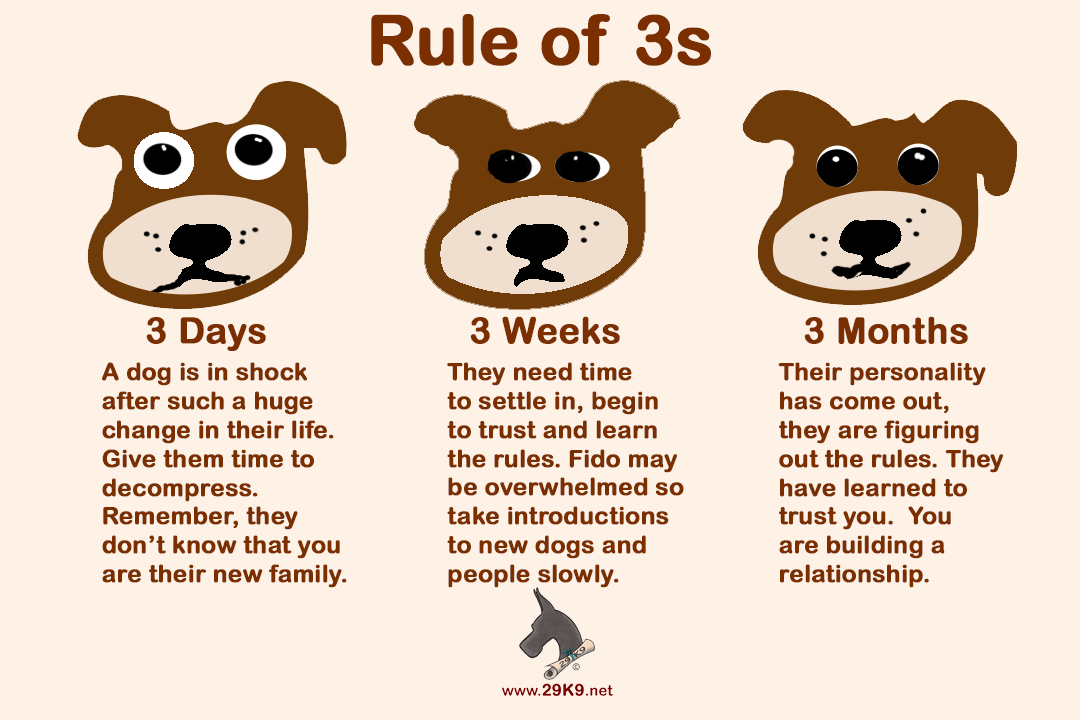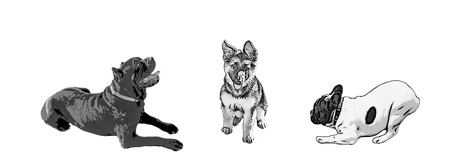|
We’ve all seen the stories of the shelter dog who finally finds his person and they live happily ever after in perfect harmony. Unfortunately, this is not the norm. When a dog ends up in a shelter they have suddenly lost their family with no idea why. The reason doesn’t matter because the dog does not know that reason, just that his home and family are gone. The rescue or shelter may be amazing but it is not their home.
It can be very hard for a dog to adjust to shelter life. Staff and volunteers come and go, as do the dogs around them. They can hear other dogs barking, sometimes in fear, as well as smell the disinfectants. They don’t know what is going to happen from one moment to the next as they are moved from one kennel to another to a play yard with strange dogs. When a person or family makes the decision to adopt the dog they are then thrown in to another new place with new people and maybe even new dogs. This also applies to the "rehomed" dog. Be patient. You will want to show off our new family member but please remember that Fido’s world has been turned upside down and he needs time to decompress and adjust. Supervision is very important to make sure he doesn’t escape his new home and is safe with the new people and pets in his life. Dogs do not generalize behaviors to all locations unless taught. They may have been house trained but that doesn’t mean they are trained to your house. They may have had a doggy door which allowed them free access. Set up a way for the dog to tell you they have to go by using a bell hanging from the door. Take them out frequently, ringing the bell before you open the door. Soon Fido will be ringing the bell to let you know. For the first three weeks your new dog is building his trust in you and learning some of the family rules. Separate Fido from children and other pets when you are not there to actively supervise. What may be normal activity in your home may not be something he is familiar with and may cause fear. He needs time to process and learn the family rules. Now is not the time to take him to the dog park. You will start to see his personality come out. You may also see some challenges that need to be addressed with a positive reinforcement trainer. It takes about 3 months for most dogs to fully adjust. Fido may need a trainer to help him learn how to follow family rules, social skills, leash training and safely introducing to new dogs and environments. Adding lots of enrichment can help him learn to settle and keep him out of trouble. A great resource for bringing home an adult dog is Patricia McConnell, PhD book Love Has No Age Limit, Welcoming an Adult Dog Into Your Home. She discusses the Rule of 3s and how to apply it to making your new family member feel welcome and wanted.
0 Comments
First Introductions
First introductions should be outside, preferably in neutral turf. Take the dogs on a side by side walk. This helps tire an active puppy and while providing a happy back drop before entering the yard and home. Supervise It is important that all early interactions be supervised. Whether a new puppy or an older dog it can take a few weeks for everyone to get used to the new family member and new normal. Watching body language closely during this adjustment period can help prevent future problems. Separate the dogs if you are not able to closely supervise, especially during the first 3 weeks, until they have time to adjust to each other. Separate Baby Gates, crates and Xpens make great separators so that the dogs can have down time where they feel safe and comfortable. Separate eating areas since new puppies can be overly curious and older dogs may not appreciate a puppy interrupting them. Escape Route Make sure there is always an escape route so that the dogs don’t feel cornered. Have a clear path to get away can make the difference in whether a dog goes for the bite or not. No Punishment No matter what happens do not punish either dog. Punishment can make a bad association between the dogs resulting in escalation of aggressive type behaviors. Reward Reward when the dogs are getting along, whether playing with or simply being in the same room, be sure to reward with attention, special treats or even going outside. This will help cement that good things happen when the other dog is around. Intervene Watch for body language that indicates a problem may develop and intervene early with time apart to de-escalate. Older dogs may be tolerant up to a point so watching their eyes, ears, tail position and watch the puppy for signs that he is getting too ‘in the face’ of the older dog and needs time apart to calm down. Time Give the dogs time to become acquainted and adjusted. This creates a foundation rather than forcing them into a relationship that isn’t comfortable. Following the Rule of 3s, after about 3 weeks you should see things moving toward a comfortable co-existence and, depending upon the ages, playing together. Warnings Watch the body language. Lots of licking can be a sign of increasing anxiety which means the dog is not adjusting to the new dog. If the puppy yelps and the older dog does not back off but instead escalates it’s time for a break. You’ve hit the 3 week mark with no improvement. Any of these should net a consult with a fear-free professional.  As the song says, "All I'm askin' Is for a little respect". Pet owners often tell me that, in preparation for having a baby, they have started pulling tails and ears in order to get the dog "used to it" before the baby comes. The dog is not 'getting used to it" but is simply tolerating something that is annoying, uncomfortable and may even be painful. It may even increase their anxiety. Tolerance only goes so far, tho, and then a dog may decide enough is enough. If someone was poking you with their finger how long would you tolerate the behavior before finally reacting? You can say "stop" but a dog can only say it thru body language before they eventually resort to biting. If you aren't going to stop your child from pulling the dog's ears then separate them. How does Fido say "enough, I'm not comfortable with this"? You may notice the dog licking you and/or the baby. Yawning. Very round or "whale eye" (where the white is quite visible). Lip licking. Ears pinned back. Tail tucked. Body shifts away. Whining. Lip lifting / showing teeth. Growling. These are all ways the dog is telling you they are not comfortable. What should you NOT do? Punish the dog who is trying to tell you there is a problem. Respect your dog and teaching your child to respect the dog you will help you protect them both. A false sense of security can develop when a baby first comes home. The dog may be curious and even want to be near this new bundle that is taking up so much of your attention. You let your guard down, feeling a sense of relief that Fido appears to be accepting the baby. The baby, tho, is pretty stationary at this point. As months pass and the baby becomes more mobile, as well as more curious about the dog, Fido's anxiety can build. Baby's are unpredictable and some dogs don't handle this as well while some may tolerate for awhile but may eventually say "enough". What SHOULD you do? Institute a very strict supervision and separation plan. Try to keep yourself positioned between the child and the dog, offering treats to the dog. Use stuffed toys to show the child how to pet the dog and make sure you are always there. Teach them to never put their face near a dog's face. Don't leave them alone for a moment as a quick run to another room to get your phone or a soda or that project you were working on could spell disaster, remember dogs and babies are FAST. They only need a moment for something to go wrong. When separating the dog be sure not to make it a punishment. It's a great time for the dog to enjoy a snuffle mat, stuffed Kong, or a favorite toy while in their own space. Hire a reward based or Fear-Free certified trainer who is experienced in behavior challenges, a behaviorist or Veterinary Behaviorist to work with your family and the dog. Talk to the vet and make sure there aren't any physical causes for the dog to be anxious. Even a small tug on an ear or tail or the pat of a hand or a toddler climbing on the dog could be painful for an arthritic dog, prompting the dog to be less tolerant. It's our job to protect both the child AND the dog. The bond between a child and dog can be wonderful but it needs to be safe. |
Ronda WarywodaCPDT-KA, UW-AAB Categories
All
Archives
July 2023
|


